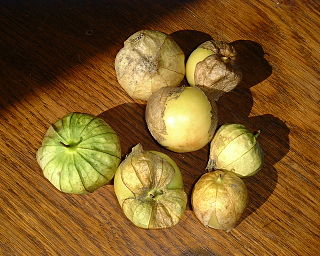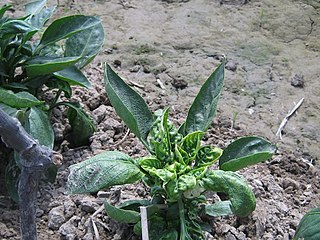
The tomatillo, also known as the Mexican husk tomato, is a plant of the nightshade family bearing small, spherical, and green or green-purple fruit of the same name. Tomatillos originated in Mexico and were cultivated in the pre-Columbian era. A staple of Mexican cuisine, they are eaten raw and cooked in a variety of dishes, particularly salsa verde. The tomatillo is a perennial plant, but is generally grown for agriculture each year as if it were an annual.

The silverleaf whitefly is one of several species of whitefly that are currently important agricultural pests. A review in 2011 concluded that the silverleaf whitefly is actually a species complex containing at least 40 morphologically indistinguishable species.

Begomovirus is a genus of viruses, in the family Geminiviridae. They are plant viruses that as a group have a very wide host range, infecting dicotyledonous plants. Worldwide they are responsible for a considerable amount of economic damage to many important crops such as tomatoes, beans, squash, cassava and cotton. There are 445 species in this genus.
Tombusvirus is a genus of viruses, in the family Tombusviridae. Plants serve as natural hosts. There are 17 species in this genus. Symptoms associated with this genus include mosaic. The name of the genus comes from Tomato bushy stunt virus.

Curly top is a viral disease that affects many crops. This disease causes plants to become smaller in size, have shriveled petals and leaves, and are twisted and pulled out of shape. They are often caused by curtoviruses, members of the virus family Geminiviridae. This disease is important in western United States, such as California, Utah, Washington, and Idaho.
Cotton leaf curl viruses (CLCuV) are a number of plant pathogenic virus species of the family Geminiviridae.
Tomato yellow leaf curl virus (TYLCV) is a DNA virus from the genus Begomovirus and the family Geminiviridae. TYLCV causes the most destructive disease of tomato, and it can be found in tropical and subtropical regions causing severe economic losses. This virus is transmitted by an insect vector from the family Aleyrodidae and order Hemiptera, the whitefly Bemisia tabaci, commonly known as the silverleaf whitefly or the sweet potato whitefly. The primary host for TYLCV is the tomato plant, and other plant hosts where TYLCV infection has been found include eggplants, potatoes, tobacco, beans, and peppers. Due to the rapid spread of TYLCV in the last few decades, there is an increased focus in research trying to understand and control this damaging pathogen. Some interesting findings include the virus being sexually transmitted from infected males to non-infected females, and an evidence that TYLCV is transovarially transmitted to offspring for two generations.
Alphasatellites are a single-stranded DNA family of satellite viruses that depend on the presence of another virus to replicate their genomes. As such, they have minimal genomes with very low genomic redundancy. The genome is a single circular single strand DNA molecule. The first alphasatellites were described in 1999 and were associated with cotton leaf curl disease and Ageratum yellow vein disease. As begomoviruses are being characterised at the molecular level an increasing number of alphasatellites are being described.
Mastrevirus is a genus of ssDNA viruses, in the family Geminiviridae. Mostly monocotyledonous plants serve as natural hosts. They are vectored by planthoppers. There are 45 species in this genus. Diseases associated with this genus include: maize streak virus: maize streak disease (MSD).
Torradovirus is a genus of viruses in the order Picornavirales, in the family Secoviridae. Plants serve as natural hosts. There are six species in this genus. Diseases associated with this genus include: torrado disease: severe necrosis of leaves and fruits.

Pepper leaf curl virus(PepLCV) is a DNA virus from the genus Begomovirus and the family Geminiviridae. PepLCV causes severe disease especially in pepper (Capsicum spp.). It can be found in tropical and subtropical regions such as Thailand and India, but has also been detected in countries such as the United States and Nigeria. This virus is transmitted by an insect vector from the family Aleyrodidae and order Hemiptera, the whitefly Bemisia tabaci. The primary host for PepLCV are several Capsicum spp.. PepLCV has been responsible for several epidemics and causes severe economic losses. It is the focus of research trying to understand the genetic basis of resistance. Currently, a source of resistance to the virus has been identified in the Bhut Jolokia pepper.
Chilli leaf curl virus(ChiLCV) is a DNA virus from the genus Begomovirus and the family Geminiviridae. ChiLCV causes severe disease especially in pepper (Capsicum spp.), but also affects other crops such as tomato (Solanum lycopersicum). It can be found in tropical and subtropical regions primarily in India, but has also been detected in countries such as Indonesia and Sri Lanka. This virus is transmitted by an insect vector from the family Aleyrodidae and order Hemiptera, the whitefly Bemisia tabaci. The primary host for ChiLCV are several Capsicum spp., but host species also include tomato and amaranth. ChiLCV has been responsible for several epidemics and causes severe economic losses. It is the focus of research trying to understand the genetic basis of resistance. Currently, a few sources of resistance have been discovered and used to breed resistant varieties.
Papaya leaf curl virus(PaLCuV) is a DNA virus from the genus Begomovirus and the family Geminiviridae. PaLCuV causes severe disease in papaya (Carica papaya), but can sometimes infect other crops such as tobacco or tomato. It can be found in tropical and subtropical regions primarily in India, but closely related species have also been detected in countries such as China, Malaysia, Nigeria and South Korea. This virus is transmitted by an insect vector from the family Aleyrodidae and order Hemiptera, the whitefly Bemisia tabaci. PaLCuV has been responsible for several epidemics and causes severe economic losses. Because of the broad diversity of these viruses, their characterization and control remains difficult.
Wheat mosaic virus can refer to a few different virus species:

Sweet potato leaf curl virus is commonly abbreviated SPLCV. Select isolates are referred to as SPLCV followed by an abbreviation of where they were isolated. For example, the Brazilian isolate is referred to as SPLCV-Br.
Tomato yellow leaf curl China virus (TYLCCNV) is a virus which contains 25 isolates. It infects plants as different as tobacco and tomato, as well as genetically modified plants. Petunias can be infected, but show no symptoms. The microbiology of the virus has been studied in the Chinese province of Yunnan. Tomato yellow leaf curl China virus belongs to the genus Begomovirus, which also contains the tomato leaf curl China virus.
Tomato leaf curl China virus is a virus that infects tomato plants in China and was first described in 2011. The virus infects tomatoes in the Chinese province of Guangxi, and it is transmitted by the whitefly. The current EPPO name is TOLCCV, but its original name in the literature was ToLCCNV.
Tolecusatellitidae is a incertae sedis ssDNA/ssDNA(+) family of biological satellites. The family contains two genera and 131 species. This family of viruses depend on the presence of another virus to replicate their genomes, as such they have minimal genomes with very low genomic redundancy.





